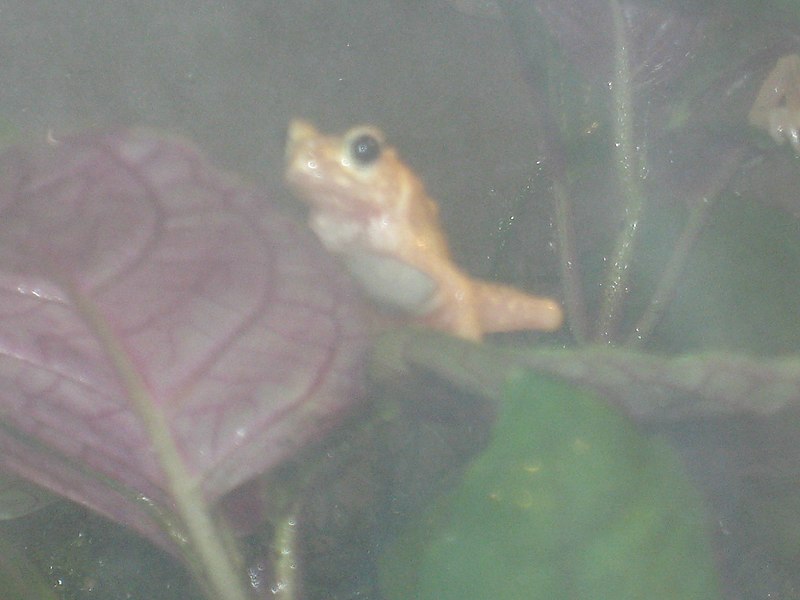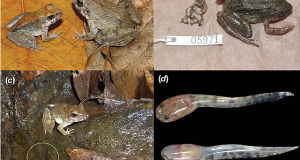
In the year 2000 I had the good fortune to work with the world’s sole surviving group of Kihansi Spray Toads (Nectophrynoides asperginis). Last seen in the wild in 2004, and declared extinct in nature soon after, the 499 individuals sent to the Bronx and Toledo Zoos represented the species’ last chance. Recently (August, 2010), I received the pleasant news that a group was sent back to Tanzania for possible reintroduction.
Discovered and Driven to Extinction Within 3 Years!
The minute, yellow Kihansi Spray Toad was only “discovered” in 1996, and its entire range – a mere 5 acres in area, was limited to the spray zone of a waterfall in the Kihansi Gorge, Tanzania. A dam deemed vital to Tanzania’s economy was built nearby in 1999…destroying the spray zone and sealing the toad’s fate.
Captive Husbandry
At the Bronx Zoo, we were able to meet our miniscule guests’ temperature and humidity requirements, but feeding presented a dilemma. The adults are tiny – 2 could perch easily on my thumbnail – and they give birth to live, fully-formed little toads (there is no tadpole stage). These are incredibly small (a single female could bear 25 at once) – hard to even see, much less feed; pinhead crickets were too large for many newborns!
We relied primarily upon nutrient-loaded pinheads, springtails (tiny insects) and fruit flies, but I was concerned that such did not comprise a balanced diet. I collected tiny leaf-litter invertebrates (newly hatched millipedes, nematodes, ants, etc.) and fed these to the toads whenever possible. Please see the article noted below for information on collecting leaf litter invertebrates – they are an invaluable food source for Poison Frogs, Mantellas, skink hatchlings and other tiny herps.
An Uncertain Future
All went well, and the captive Spray Toad population, held at the Toledo and Bronx Zoos, now stands at 6,500+.
The 100 individuals that have been returned to Tanzania are living at a propagation center in Dar es Salaam. A sprinkler system is being installed in the toads’ former habitat…once it is thoroughly tested and environmental conditions are monitored, the toads can hopefully be reintroduced to the wild.
Further Reading
IUCN Summary of the Spray Toad’s natural history and conservation status.
Collecting Leaf Litter Invertebrates
Kihansi Spray Toad image referenced from wikipedia and originally posted by Ruby 1×2
 That Reptile Blog – Reptile, Amphibian and Exotic Pet Care and Information
That Reptile Blog – Reptile, Amphibian and Exotic Pet Care and Information



Hello Frank,
With species that do well in zoos like this-is their ever a chance hobbyists would get a chance to work with them? Another good example is zeteki-heard a lot of zoos are no longer actively rearing the tadpoles. Seems that the surplus could be given to private breeders to allow for furtherance of knowledge(as well as resulting in a potentially huge captive population with no expense on the zoos part).
I know that politics, animal rights activists, and special protocols to ensure maximum genetic diversity would make this pretty much impossible-but I can dream on I guess!
~Joseph
Hello Joseph, Frank Indiviglio here.
Thanks for your thoughts. What you suggest is much needed, as zoos cannot begin to handle the work needed (as of 15 yrs ago, all the world’s zoos could fit within Brooklyn, NY – maybe a bit more now, but not enough). A few years back I went to FLa to help rehab/place 10,000+ turtles that had been seized in s. China; that and similar incidents led to the formation of the Turtle Survival Alliance, a cooperative effort between zoos and hobbyists. Many turtle people with space and money helped out – 2 I know of in NYC and suburbs each have 2,000 – 2,500 specimens – few zoos have similar space or funds, and in any case such rarely go to herps. The whole Fla operation took place on the land of an importer/breeder; he had over 80 ponds available, did not charge the organization. Sadly, not much came of it, the organization now largely shuns private folks from what I understand and the person who supplied the site in Fla was, from what I gather, really treated terribly.
Another recent effort for frogs sought to place animals taken from the path of Chytrid in botanical gardens and similar institutions…private folks were mentioned but nothing of substance developed.
Sad but, as you say, the politics are brutal….
Good luck and please keep me posted.
Best regards, Frank Indiviglio.
Frank , that is fantastic
Thanks…my good fortune to have been involved. I think it’s a great project to use as a template for others, etc; but of course there are many harsh realities – was only possible because Bx Zoo and US groups were able to invest huge amounts of money , time and expertise; red tape was amazing; frogs will not survive w/o constant habitat management; local gov’t cooperation etc…but it’s what we have to work with, and the frogs do well in zoos if their very specific needs are met,. glad you enjoyed, thanks, frank